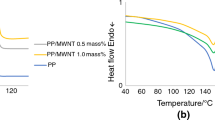Abstract
This paper focuses on the numerical simulation of the mixing stage of injection molding process, for polypropylene/multi-walled carbon nanotube (PP/MWCNT) nanocomposites. First, a twin-screw mixer had been employed for preparing polypropylene nanocomposites loaded at 2, 5, and 10 wt% of MWCNT. Then, a characterization of rheological behavior for polypropylene as well as polypropylene/multi-walled carbon nanotube mixtures, at three temperatures (180, 200, and 220 °C,) has been carried out using capillary rheometer, in order to build a consistent flow model. The second part of the paper concerns the design of a transparent front wall for the twin-screw mixer in order to measure the temperature field for the PP in the twin-screw mixer cavity using infrared camera with high-quality thermal imaging. The final part is mainly devoted to the modeling of the polymer-filler flow during the mixing stage using the finite element method. Both PP and MWCNT have been mixed by using a twin-screw mixer. A proper agreement between numerical simulation and experimental results concerning mixing torque and mixing index as well as temperature fields has been obtained.
Similar content being viewed by others
References
Hwan Chun D (1999) Cavity filling analyses of injection molding simulation: bubble and weld line formation. J Mater Process Technol 89–90:177–181
Zhang J, Sahli M, Gelin JC, Khan-Malek C (2013) Experimental analysis of the evolution of the physical properties of pyramidal-shaped metallic replicas made using the MIM process. Int J Adv Manuf Technol 68:1063–1074
Sahli M, Lebied A, Gelin J.C, Barriere T, Necib B, (2015) Numerical simulation and experimental analysis of solid-state sintering response of 316 L stainless steel micro-parts manufactured by metal injection molding. Int. J. Adv. Manuf. Technol. In print.
McDonagh M (1987) Mixers for powder/liquid dispersion. The Chemical Engineer 29–32
Gaoming D, Leon M Jr (2015) Carbon nanotube reinforced hybrid composites: computational modeling of environmental fatigue and usability for wind blades. Compos Part B 78:349–360
Jibran SZM, Volkan E (2015) Investigating the mechanical properties of single walled carbon nanotube reinforced epoxy composite through finite element modelling. Compos Part B 71:1–9
Nasir MU, Franco MC, Bakhtier F (2012) Molecular dynamics simulations of carbon nanotube dispersions in water: effects of nanotube length, diameter, chirality and surfactant structures. Comput Mater Sci 53(2012):133–144
Rouhi S, Alizadeh Y, Ansari R (2014) Molecular dynamics simulations of the single-walled carbon nanotubes/poly (phenylacetylene) nanocomposites. Superlattice Microst 72:204–218
Sharif A, Masud AKM (2014) Evaluation of effective thermal conductivity of multiwalled carbon nanotube reinforced polymer composites using finite element method and continuum model. Procedia Eng 90:129–135
Akdogan H, McHugh TH (1999) Twin screw extrusion of peach puree: rheological properties and product characteristics. J Food Process and Preserva 23:285–305
Kenji I, Motoo Y, Michitaka S, Mitsuaki H, Ko H (2009) Simulation of dispersion and collection process of agglomerated particles in collision with fibers using discrete element method. Adv Powder Technol 20:582–587
Shunliang J, Zhiguo W, Goufa Z, Weimin Y (2007) An implicit control-volume finite element method and its time step strategies for injection molding simulation. Comput Chem Eng 31:1407–1418
Yangyang G, Jun L, Jianxiang S, Liqun Z, Dapeng C (2014) Molecular dynamics simulation of dispersion and aggregation kinetics of nanorods in polymer nanocomposites. Polymer 55:1273–1281
Andreas E, Gerold K, Gavin R, Zhenyu H, Jonathan B, Philip S, Johannes K (2014) Mechanistic modeling of modular co-rotating twin-screw extruders. Int J Pharm 474:157–176
Bouaksa F, Ovalle RC, Zaïri F, Stoclet G, Naït-Abdelaziz M, Gloaguen JM, Tamine T, Lefebvre JM (2014) Molecular chain orientation in polycarbonate during equal channel angular extrusion: Experiments and simulations. Comput Mater Sci 85:244–252
Kris F, Erik J, Robert S, Susumu G, Gemma MK (2013) Thermoplastic starch films: DOE and O2PLS methodology for optimization and increased understanding of polymer processing. Polym Test 32:343–352
Thiébaud F, Gelin JC (2010) Characterization of rheological behaviors of polypropylene/carbon nanotubes composites and modeling their flow in a twin-screw mixer. Compos Sci Technol 70:647–656
Fasina OO, Hallman H, Craig-Schmidt M, Clements C (2006) Predicting temperature-dependence viscosity of vegetable oils from fatty acid composition. J Am Oil Chem Soc 83:899–903
Carreau P, Kee D.De, Chhabra O (1997) Rheology of polymeric systems: principles and applications. Munich Hanser
Cross MM (1965) Rheology of non-newtonian fluids: a new flow equation for pseudoplastic systems. J Colloid Sci 20:417–437
Gelin JC, Barriere T, Song J (2010) Processing defects and resulting mechanical properties after metal injection molding. J Eng Mater Technol 132:11–17, Transaction of ASME 2010
Cheng JJ, Manas-Zloczower I (1990) Flow field characterization in a banbury mixer. Int Polym Process 3:178–183
Kelarakis A, Yoon K, Sics I, Somani RH, Chen X, Hsiao BS, Chu B (2006) Shear-induced orientation and structure development in isotactic polypropylene melt containing modified carbon nanofibers. J Macromol Sci 45:247–261
Djoudi H, Gelin J.C, Barriere T (2012) Numerical and experiments results of mixing process for polymers and loaded polymers with nano particles. Steel Research International, Wiley-VCH Verlag GmbH, 911–914
Author information
Authors and Affiliations
Corresponding author
Rights and permissions
About this article
Cite this article
Djoudi, H., Gelin, J.C. & Barriere, T. Elaboration of polypropylene/carbon nanotubes by twin-screw mixer and identification of rheological behavior. Int J Adv Manuf Technol 83, 1659–1670 (2016). https://doi.org/10.1007/s00170-015-7665-2
Received:
Accepted:
Published:
Issue Date:
DOI: https://doi.org/10.1007/s00170-015-7665-2




